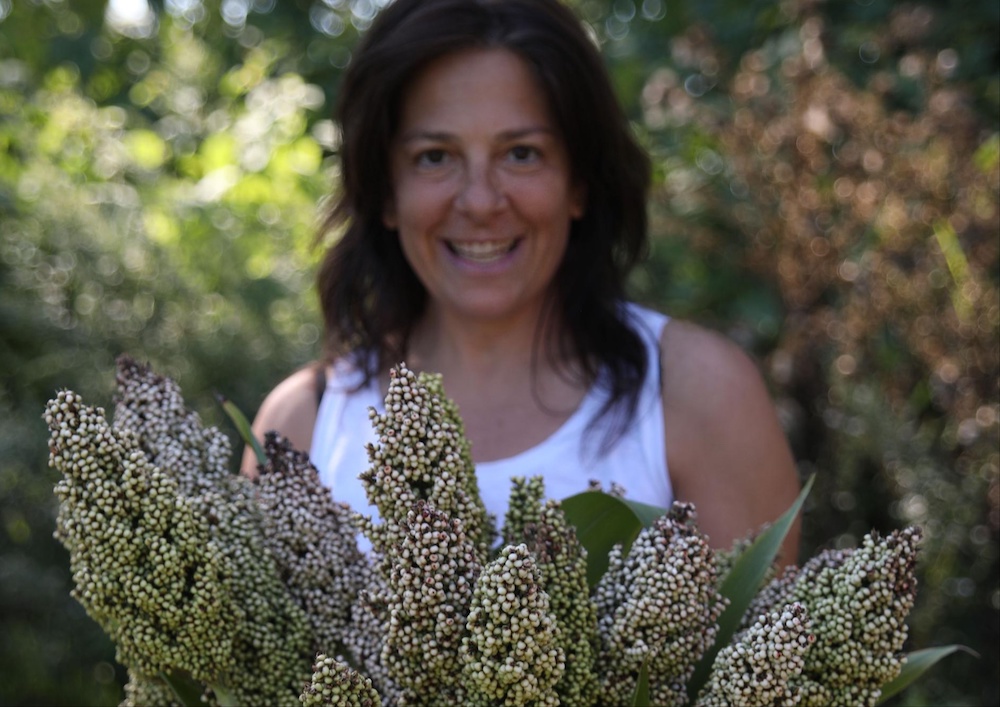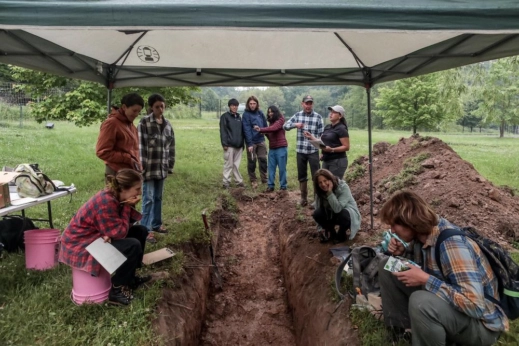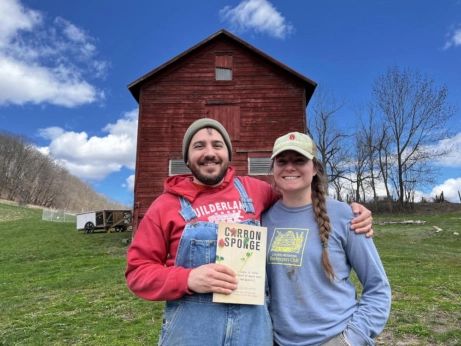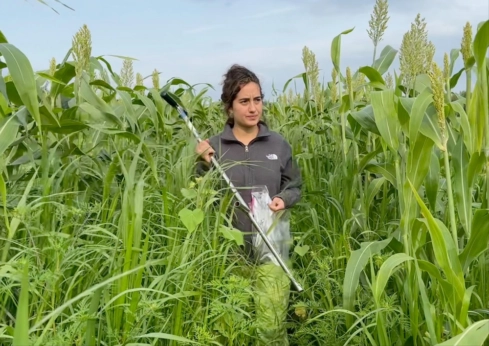Putting soil first, artist Brooke Singer founded Carbon Sponge for anyone to make positive change for the climate.

Brooke Singer may laugh when she calls herself “a self-taught soil nerd,” but she is quite serious. When Singer looks at soil, she sees something beyond just the microbes, minerals and organic matter that comprise the earth’s most biodiverse ecosystem. She sees something incredible, “teeming with life and diversity,” she says.
Singer’s respect for soil inspired her to found Carbon Sponge, an interdisciplinary platform that honors this threatened resource by cultivating healthy soil to foster carbon sequestration. “Carbon sponge” is a term usually used to describe healthy soil that absorbs and retains water; Singer found it aptly described the subject and actions she wants to cultivate.
Fighting climate change
Greenhouse gas emissions, which result from high levels of atmospheric carbon, are a critical cause of climate change. That systemic shift is responsible for weather patterns, such as periods of intense drought or rain, imperiling all aspects of life, particularly our food supply. Yet agriculture in the United States is responsible for about 10 percent of the country’s emissions and food production accounts for more than a quarter of global emissions, when factoring in the larger food system, including packaging and transportation.
Carbon storage is an important tool in combating climate issues because sequestered carbon produces fewer emissions. It also improves soil’s fertility, its structure for conveying nutrients and capacity to retain water. Healthy soil is more productive and leads to better growing and farming outcomes.
Singer hopes to fight climate challenges and generate a societal shift in which decisions about land use practices, such as fracking, are thoughtfully made to support humans and other species that rely upon the ecosystem. Carbon Sponge, she says, is “part of our nature-based solution[s] to our man-made problems.”

An event with USDA scientists, organized by Carbon Sponge, at White Feather Farm in 2023. (Photo credit: Jess Giacobbe)
Anybody who is interested—urban, suburban or rural gardeners and farmers or any land stewards—can participate in Carbon Sponge. Singer has written a manual, “Carbon Sponge Guide: A Guide to Grow Carbon in Urban Soils (and Beyond),” available on the Carbon Sponge website. It explains how to assemble a toolkit of inexpensive, easy-to-purchase-and-use instruments to test metrics such as the fungal to bacterial ratio, which indicates soil’s ability to provide hospitable conditions for carbon storage. Chapters discuss how to monitor and teach children about soil and to design a carbon sponge. An educator at heart, Singer wants to offer tools to teach people to develop new ways of thinking.
Putting soil first
Centering soil in conversations is at the heart of Carbon Sponge. “First of all, asking, what does soil need? Which I think is an interesting question unto itself,” says Singer. “Then also, ‘what can we learn from soil?’”
Farming methods over the past 50 years, such as growing monocultures and fertilizing depleted soil to prop up the system, are shortsighted, says Singer. She wants to invest in rather than impose on or extract from soil. “If you’re just looking at a yield and how much you get on the land, then you’re not understanding the complex systems that support the growth of that plant and future growth,” she says.
Singer is notably not a scientist. She’s an award-winning professor of New Media at SUNY Purchase where she teaches Dark Ecology, a class closely aligned with her work in the ecological art space. It explores what it means to be human in the age of the Anthropocene, reading theorists, she says, who straddle art and science and think about how those disciplines can help people interrogate and rethink humans in relation to soil, microbes and the food we’re growing. Singer’s work, at the intersection of technology, art and social change, has been exhibited at MoMA/PS1 and is in the collections of the Whitney Museum of American Art.

Fabio and Christine Ritmo of Nimble Roots Farm in Catskill, NY, a participating farm of Carbon Sponge Hub 2022-2024. (Photo credit: Brooke Singer)
After participating in collaborative art projects involving food waste, Singer wanted to learn more about soil. She also wanted to transform that waste into a rich resource. Those interests led her to co-found La Casita Verde, a community garden in South Williamsburg, Brooklyn.
Singer had worked a lot with data collection, visualizing data in her art practice and generating data in various projects. Learning that the soil had to be tested for lead, a common contaminant in urban soil, prompted her to wonder what it was not being tested for and what would be useful to the soil. “What other kinds of data could we collect in the garden,” says Singer, “that kind of filled out the story about soil?”
Group effort
Carbon Sponge, formed to explore regenerative agriculture in urban gardening, incorporates art, scientific research, data collection and agriculture. For its initial project in 2018, Singer, as designer in residence at the New York Hall of Science, assembled soil scientists, artists, agroecologists, urban gardeners, landscape designers, government agencies and corporate funders. The goal: to find out how carbon cycles in urban soils and if it was possible to grow soil organic carbon in urban soils in the same way that happens in native rural soils. “I was very interested in making an aesthetic and pleasing experiment so that people would be pulled in by it and want to be in this space and start to learn and ask questions with us,” says Singer.
Urban soil is very different from rural soil, which is much less disturbed by humans. So, the experiment combined “technosol,” also known as human-engineered soil, a mix of sediment and compost, in different ratios. It demonstrated that soil organic carbon could be developed in urban soil.
The findings are important because the sediment, previously considered waste, can now be considered a resource, opening up new potential for use in ecosystem services and regenerative agriculture. A paper detailing results is currently under peer review.
Singer’s integrative, collaborative approach and activist streak are influenced by her time at Carnegie Mellon University, where she earned her MFA. There she co-founded Preemptive Media, a collective of artists, computer scientists and roboticists who explored the then-new field of human and computer interaction. She enjoyed being part of a group that “included people who knew how to build projects both in the physical and technological sense and create projects that were bigger than one person,” she says, “and often with an eye towards inclusion, participation, transparency and building a better world with more of a democratic input.”
Carbon Sponge now also encompasses scientific research, Singer’s art practice, a farmer-to-farmer network called Carbon Sponge Hub (located since 2022 at White Feather Farm in Saugerties, New York, where Singer is the director of Farm Innovation), and a yearly soil fest there.

Anne-Laure White, Carbon Sponge field tech, surveying the sorghum crop at Stoneberry Farm in Athens, NY, in 2023. (Photo credit: Brooke Singer)
Last year, 10 small area farms participated in the Hub, which includes professional lab testing to substantiate kit results. Planning for 2024 is underway, with intentions to scale up production from a hand-harvested-and-winnowed operation to a machine-driven one, to formally verify the kit, thanks to a USDA grant, and to explore culinary uses.
The Hub is also growing sorghum alone and in cover crop mixes for a scientific study to determine if sorghum can be called a “New York climate-smart plant.” The nutritious grain from Africa possesses numerous agronomic and sustainable properties that can help soil store carbon. It is drought resistant and produces a significant amount of plant biomass, which can be used by farmers to nurture the land. Notably, it efficiently photosynthesizes more “exudates” (“basically, liquid carbon,” explains Singer) into the soil through its vast root system, which helps microbes multiply, building soil health. Hub farm Zena Farmstead reported a 50-percent increase in microbial biomass in its experimental plot from its first to second year of participation.
Looking ahead
Current generations may not see the benefits of this work; carbon sequestration can take many decades. But Singer is undeterred. “This provides one model,” she says. “We have to be on soil time, which is very different than human time. Both should be part of the solution.”
Carbon Sponge is modeling new ways of thinking that are necessary for human survival. “We can’t get ourselves out of this problem in the same way we got into it, with extractive capitalists and profit-driven systems,” says Singer. “I’d like to think of this as a different way forward.”
***
You can find Singer’s manual, “Carbon Sponge Guide: A Guide to Grow Carbon in Urban Soils (and Beyond),” on the Carbon Sponge website. It explains how to assemble a toolkit of inexpensive, easy-to-purchase-and-use instruments to test metrics such as the fungal to bacterial ratio, which indicates soil’s ability to store carbon.
Yes, some good ideas for improving soil health. One BIG Problem. How long does the carbon stay in the sponge Several Million years??? Any things less than that and we are “just spittn into the wind” as the old farmer would say. Thins like this are little more that “cutessy, kinda fun feel good” little activities. Here is a better idea Plant trees THEN and this is the critical part Harvest the trees for fuel. YES,YES I know that dumps CO2 back into the air BUT it replaces fossil fuel which dumps CO2 that has been locked away for millions… Read more »